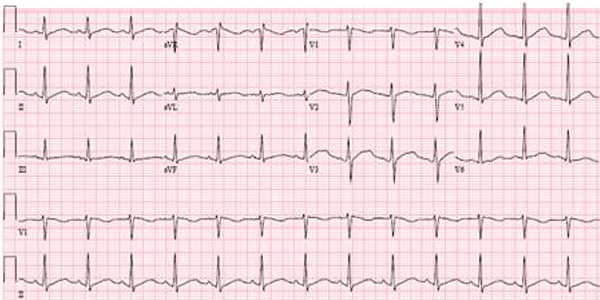Hydroxychloroquine on the Electrocardiogram
Hydroxychloroquine is a 4-aminoquinoline derived from chloroquine with immunosuppressive, antiautophagic and anti-malarial activities 1.
It is indicated in the treatment of acute attacks or prophylaxis of uncomplicated malaria caused by Plasmodium vivax, P. falciparum, P. ovale and P. malariae, and of rheumatic diseases such as rheumatoid arthritis and systemic and discoid lupus erythematosus 2 3.
Effects of Hydroxychloroquine
- Interferes with digestive vacuole function within sensitive malarial parasites by increasing the pH and interfering with lysosomal degradation of hemoglobin 2.
- Inhibits locomotion of neutrophils and chemotaxis of eosinophils 2.
- Impairs complement-dependent antigen-antibody reactions 2.
Hydroxychloroquine Side Effects
Hydroxychloroquine may cause side effects such as gastrointestinal disorders (the most common, up to 12% of patients may have vomiting, nausea, diarrhea, or abdominal pain), dermatological disorders in up to 3% of cases, ophthalmological (retinopathy, disorders of accommodation), cardiological (see below), haematological (myelosuppression, aplastic anaemia, granulocytosis, leukopenia, thrombocytopenia, porphyria), neurological (convulsions, vertigo, headache, extrapyramidal phenomena) 2 4.
It may also cause hypoglycaemia and hypokalemia, which can lead to severe, irreversible hearing loss, myopathy and atrophy of the proximal muscle groups 2 4 5.
Cardiological side effects
The most frequent cardiac alterations caused by hydroxychloroquine are the widening of the QRS, the prolongation of the QTc interval, with an increased risk of torsades de pointes or ventricular arrhythmias.
This effect is dependent on dose, however, the effect may vary between individuals.
Hydroxycholoroquine rarely causes cardiomyopathy, which can lead to heart failure and be fatal if not suspected early 2 6.
Cardiomyopathy caused by hydroxychloroquine is usually restrictive with increased wall thickness (biventricular hypertrophy), although cases of dilated cardiomyopathy with non-thickened walls have also been described 6.
Cardiomyopathy should be suspected if ventricular dysfunction develops in a patient who is taking this drug and should be grounds for discontinuation 6.
Hydroxychloroquine may also cause other conduction disturbances such as bundle branch blocks, sick sinus syndrome or atrioventricular blocks 2 3 4.
QTc Interval Prolongation due to Hydroxychloroquine
Hydroxychloroquine interferes with ventricular repolarization and may therefore prolong the QTc interval. It should be used with caution in patients with congenital or documented long QT interval, or with known risk factors for QT interval prolongation.
The prolongation of the QTc interval may increase with increasing drug concentrations 2.
If signs of arrhythmias appear during hydroxychloroquine treatment, treatment should be discontinued, and an EKG should be performed.
It should also be used with caution during concomitant administration with drugs that prolong the QT interval, for example class IA and III antiarrhythmics, tricyclic antidepressants, antipsychotics, among others.
Hydroxychloroquine and azithromycin during COVID-19
During the COVID-19 pandemic, Gautret et al demonstrated that hydroxychloroquine is effective in eliminating nasopharyngeal viral transport of SARS-CoV-2 in patients with COVID-19 in less than six days, in most patients.

Image from ten Broeke R, Mestrom E, et al 7.
Hydroxychloroquine on the EKG: Sinus rhythm with long QT interval (QTc 580 ms).
During the COVID-19 pandemic, Gautret et al demonstrated that hydroxychloroquine is effective in clearing viral nasopharyngeal carriage of SARS-CoV-2 in patients with COVID-19 in six days or less, in most patients 8.
They also suggested a synergistic effect of the combination of hydroxychloroquine and azithromycin.
Azithromycin itself does not usually cause a significant prolongation of the QTc interval, but its combination with hydroxychloroquine could theoretically increase the risk of torsades de pointes 9.
Given the limited experience, it is advisable to monitor the QTc interval at baseline and daily during the duration of treatment, especially if administered with azithromycin 9.
It is also prudent to correct electrolyte disorders and to avoid or minimize the use of other drugs that prolong the QTc interval 9.
Related articles: QTc calculator, QT interval, hypokalemia on the EKG.
References
- 1. National Center for Biotechnology Information. PubChem Database. Hydroxychloroquine, CID=3652, https://pubchem.ncbi.nlm.nih.gov/compound/Hydroxychloroquine [accessed; Apr. 9, 2020].
- 2. Ficha técnica de la Hidroxicloroquina. AEMPS. Spain. [accessed; Apr. 9, 2020]. Available in: https://cima.aemps.es/cima/pdfs/ft/84978/FT_84978.pdf.
- 3. Marquardt K, Albertson TE. Treatment of hydroxychloroquine overdose. J Am Coll Emerg Physicians Open. 2001; 19(5): 420–424. doi: 10.1053/ajem.2001.25774.
- 4. Rainsford, K.D., Parke, A.L., Clifford-Rashotte, M. et al. Therapy and pharmacological properties of hydroxychloroquine and chloroquine in treatment of systemic lupus erythematosus, rheumatoid arthritis and related diseases. Inflammopharmacol 23, 231–269 (2015). 10.1007/s10787-015-0239-y.
- 5. Jordan P, Brookes JG, Nikolic G, et al. Hydroxychloroquine Overdose: Toxicokinetics and Management. Clinical Toxicology. 1999; 37:7, 861-864. doi: 10.1081/CLT-100102466.
- 6. Di Girolamo F, Claver E, Olivé M, et al. Dilated Cardiomyopathy and Hydroxychloroquine-induced Phospholipidosis: From Curvilinear Bodies to Clinical Suspicion. Rev Esp Cardiol. 2018;71(6)491-493 doi: 10.1016/j.recesp.2017.03.006.
- 7. ten Broeke R, Mestrom E et al. Early treatment with intravenous lipid emulsion in a potentially lethal hydroxychloroquine intoxication. Neth J Med. 2016; 74(6) [accessed; Ago. 1, 2021]. Available in: https://njmonline.nl/article_ft.php?a=1718&d=1142&i=195.
- 8. Gautret et al. Hydroxychloroquine and azithromycin as a treatment of COVID-19: results of an open- label non-randomized clinical trial. 2020 Int J Antimicrob Agents. 2020; 105949. doi: 10.1016/j.ijantimicag.2020.105949.
- 9. Juurlink DN. Safety considerations with chloroquine, hydroxychloroquine and azithromycin in the management of SARS-CoV-2 infection. CMAJ 2020. doi: 10.1503/cmaj.200528.
If you Like it... Share it.






